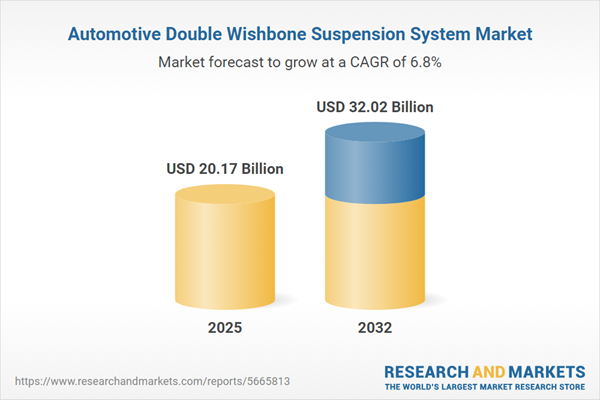Speak directly to the analyst to clarify any post sales queries you may have.
The automotive double wishbone suspension system market is navigating a period of steady growth, driven by the evolution of vehicle technologies and rising expectations for performance, comfort, and safety. Senior decision-makers face new demands as advanced vehicle architectures and regulatory pressures reshape product design, supply chains, and sourcing strategies.
Market Snapshot: Automotive Double Wishbone Suspension System Market
The Automotive Double Wishbone Suspension System Market grew from USD 18.91 billion in 2024 to USD 20.17 billion in 2025. It is expected to continue growing at a CAGR of 6.80%, reaching USD 32.02 billion by 2032. This market is underpinned by advanced suspension design, superior ride comfort, and increased adoption across sports, luxury, and utility vehicle segments. Growth is further propelled by advances in lightweight materials and the expanding roles of electric and autonomous platforms, marking double wishbone suspension as a key enabler in next-generation automotive engineering.
Scope & Segmentation of the Automotive Double Wishbone Suspension System Market
- Vehicle Types: Bus (coach, transit), heavy commercial vehicles (heavy-duty truck, light-duty truck, medium-duty truck), light commercial vehicles (pickup truck, van), hatchbacks (compact, mid-size, subcompact), sedans (compact, mid-size, full-size), SUVs (compact, mid-size, full-size).
- Component Types: Ball joints, bushings, control arms (lower control arm: double pivot, single pivot; upper control arm: dual pivot, single pivot), and knuckles.
- End Use: OEM installation and aftermarket replacement.
- Technologies: Active, semi-active, and passive suspension systems supporting integration of sensors and adaptive damping strategies.
- Materials: Aluminum, composites, and steel, offering tradeoffs in performance and cost.
- Drive Types: All-wheel, front-wheel, and rear-wheel drive, each influencing suspension geometry and dynamics.
- Geographic Coverage: Americas (North and Latin America), Europe, Middle East & Africa, Asia-Pacific—including analysis of key countries such as the United States, China, Germany, and India.
- Key Companies: ZF Friedrichshafen AG, Tenneco Inc., KYB Corporation, Hitachi Astemo Ltd., Showa Corporation, Magna International Inc., NHK Spring Co. Ltd., BWI Group Co. Ltd., Mando Corporation, Sogefi S.p.A.
Key Takeaways for Decision-Makers
- Double wishbone suspension delivers precise wheel control, enhanced handling, and superior feedback, crucial for sports, luxury, and off-road vehicle applications.
- Shifts to electric and autonomous vehicle platforms are reshaping load management, comfort, and integration with sensor suites, requiring continual innovation in damping and adaptive systems.
- Advanced materials such as high-strength aluminum alloys and engineered composites are central to lowering unsprung mass while ensuring structural integrity and durability.
- Digital prototyping and simulation platforms accelerate development cycles and support data-driven optimization of suspension geometries before production, minimizing waste and cost.
- An emphasis on collaborative development across OEMs, suppliers, and technology partners is facilitating the integration of active and semi-active suspension modules tailored for diverse regional regulatory and market requirements.
Tariff Impact on Global Sourcing and Cost Structure
Forthcoming tariff adjustments in 2025 are prompting OEMs and suppliers to rethink geographic sourcing strategies for key components such as castings and specialized bushings. Increased import levies are driving relocation of production closer to North American assembly facilities, spurring nearshoring, regional partnerships with material suppliers, and renewed focus on operational efficiency. These adaptations aim to maintain competitive cost structures and consistent product availability amid evolving regulatory challenges.
Methodology & Data Sources
This report leverages a blend of primary research, including interviews with engineering and procurement leaders, as well as exhaustive secondary analysis of technical publications, patent filings, and regulatory documents. Data triangulation is used to validate insights, while industry expert panels help ensure accuracy and relevance for strategic decision-making.
Why This Report Matters for Senior Leaders
- Delivers actionable insights into material, technology, and sourcing trends that impact capital allocation and risk mitigation strategies.
- Facilitates informed decisions on product roadmap and supplier selection amid shifting market, regulatory, and geopolitical environments.
- Enables benchmarking of leading suppliers and technology partners to align with performance, operational excellence, and market penetration initiatives.
Conclusion
With evolving platform architectures and regulatory environments, double wishbone suspension systems continue to anchor vehicle dynamics innovation. This report equips industry leaders with the intelligence needed for strategic investment, product development, and supply chain optimization.
Additional Product Information:
- Purchase of this report includes 1 year online access with quarterly updates.
- This report can be updated on request. Please contact our Customer Experience team using the Ask a Question widget on our website.
Table of Contents
3. Executive Summary
4. Market Overview
7. Cumulative Impact of Artificial Intelligence 2025
Companies Mentioned
The companies profiled in this Automotive Double Wishbone Suspension System market report include:- ZF Friedrichshafen AG
- Tenneco Inc.
- KYB Corporation
- Hitachi Astemo, Ltd.
- Showa Corporation
- Magna International Inc.
- NHK Spring Co., Ltd.
- BWI Group Co., Ltd.
- Mando Corporation
- Sogefi S.p.A.
Table Information
| Report Attribute | Details |
|---|---|
| No. of Pages | 197 |
| Published | October 2025 |
| Forecast Period | 2025 - 2032 |
| Estimated Market Value ( USD | $ 20.17 Billion |
| Forecasted Market Value ( USD | $ 32.02 Billion |
| Compound Annual Growth Rate | 6.8% |
| Regions Covered | Global |
| No. of Companies Mentioned | 11 |









